reset Oldsmobile Aurora 1998 Owner's Manuals
[x] Cancel search | Manufacturer: OLDSMOBILE, Model Year: 1998, Model line: Aurora, Model: Oldsmobile Aurora 1998Pages: 380, PDF Size: 19.75 MB
Page 27 of 380
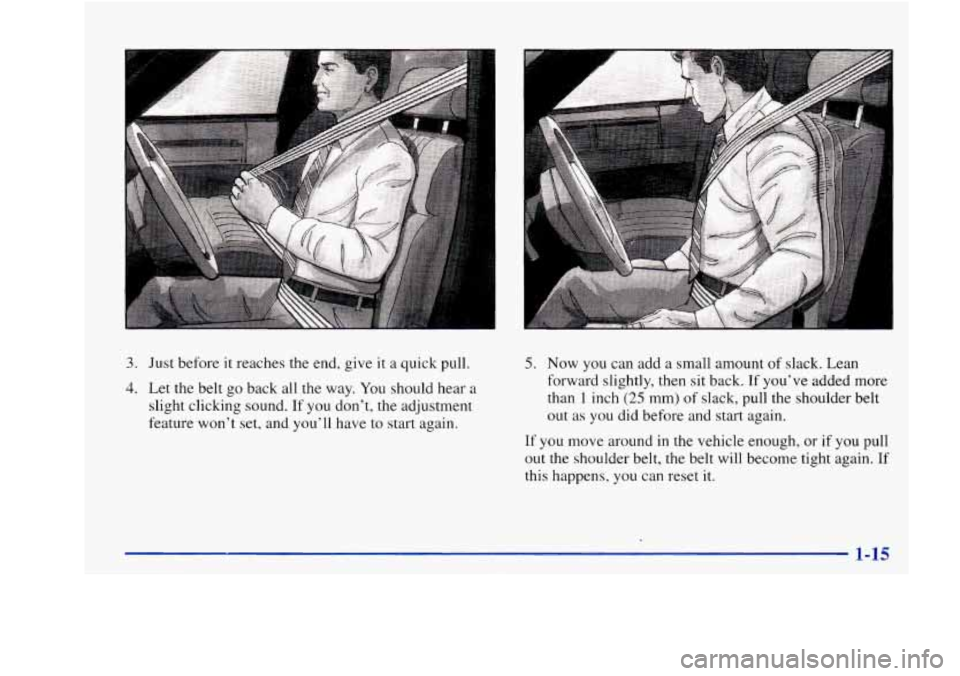
3. Just before it reaches the end, give it a quick pull.
4. Let the belt go back all the way. You should hear a
slight clicking sound. If you don’t, the adjustment
feature won’t set, and you’ll have to start again.
5. Now you can add a small amount of slack. Lean
forward slightly, then sit back.
If you’ve added more
than
1 inch (25 mm) of slack, pull the shoulder belt
out as you did before and start again.
If you move around in the vehicle enough,
or if you pull
out the shoulder belt, the belt will become tight again.
If
this happens, you can reset it.
1-15
Page 72 of 380
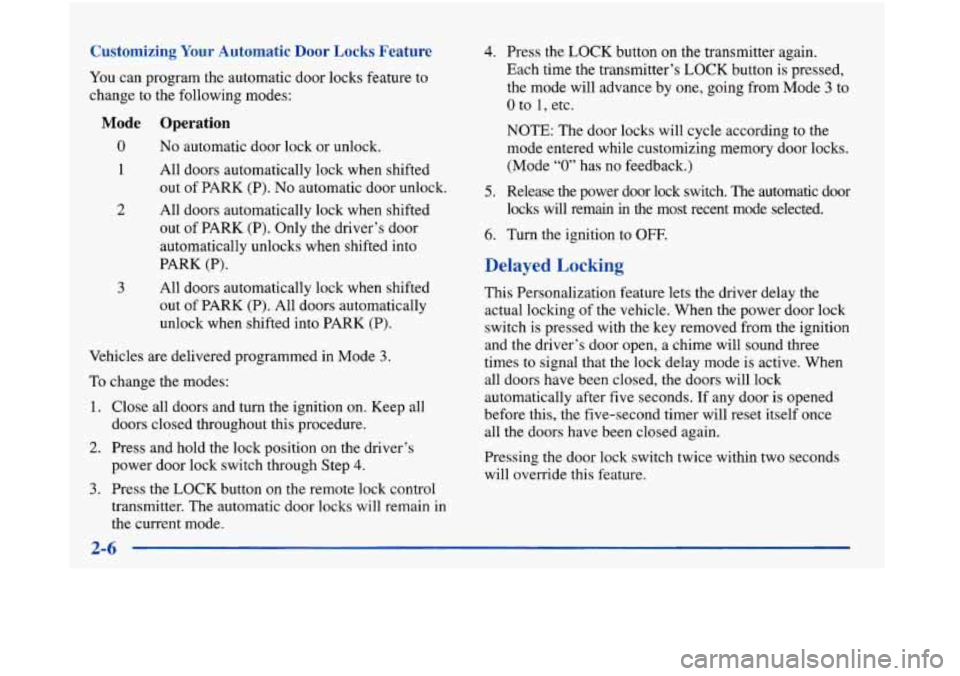
Customizing Your Automatic Door Locks Feature
You can program the automatic door locks feature to
change to the following modes:
Mode Operation
0 No automatic door lock or unlock.
1 All doors automatically lock when shifted
out of PARK (P).
No automatic door unlock.
2
3
All doors automatically lock when shifted
out of PARK
(P). Only the driver’s door
automatically unlocks when shifted into
PARK (P).
All doors automatically lock when shifted
out of PARK
(P). All doors automatically
unlock when shifted into PARK (P).
Vehicles are delivered programmed in Mode
3.
To change the modes:
1. Close all doors and turn the ignition on. Keep all
2. Press and hold the lock position on the driver’s
doors
closed throughout this procedure.
power door lock switch through Step
4.
3. Press the LOCK button on the remote lock control
transmitter. The automatic door locks will remain in
the current mode.
4. Press the LOCK button on the transmitter again.
Each time the transmitter’s
LOCK button is pressed,
the mode will advance by one, going from Mode
3 to
0 to 1, etc.
NOTE: The door locks will cycle according
to the
mode entered while customizing memory door locks.
(Mode
“0” has no feedback.)
5. Release the power door lock switch. The automatic door
locks will remain in the most recent mode selected.
6. Turn the ignition to OFF.
Delayed Locking
This Personalization feature lets the driver delay the
actual locking of the vehicle. When the power door lock
switch is pressed with the key removed from the ignition
and the driver’s door open, a chime will sound three
times to signal that the lock delay mode
is active. When
all doors have been closed, the doors will lock
automatically after five seconds. If any door
is opened
before this, the five-second timer will reset itself once
all
the doors have been closed again.
Pressing the door lock switch twice within two seconds will override this feature.
2-6
Page 105 of 380
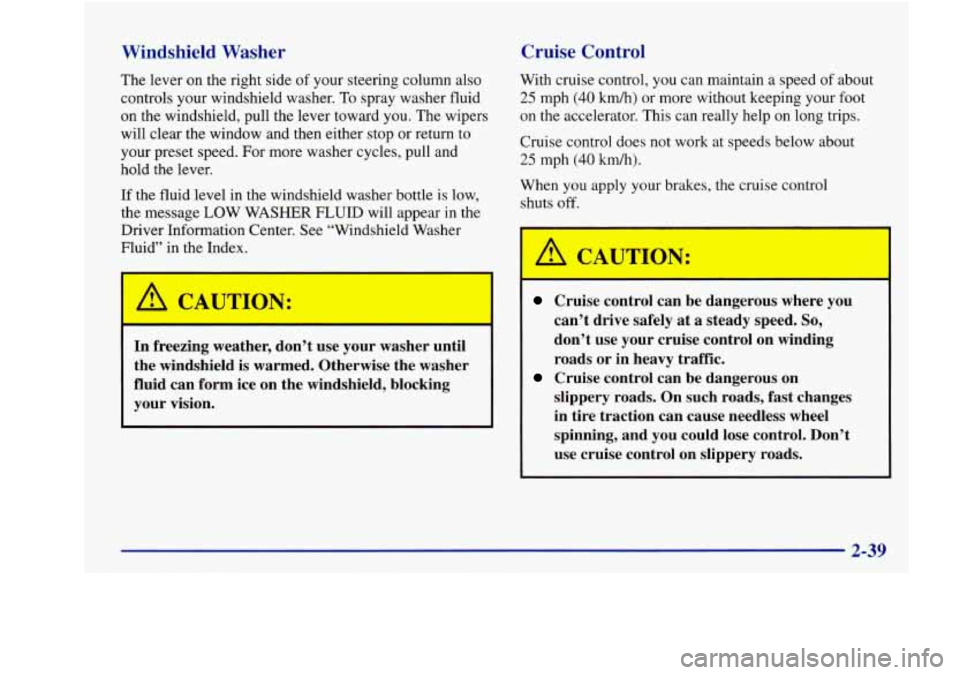
Windshield Washer Cruise Control
The
lever on the right side of your steering column also
controls your windshield washer. To spray washer fluid
on the windshield, pull the lever toward
you. The wipers
will clear the window and then either stop or return to
your preset speed. For more washer cycles, pull and
hold the lever.
If the fluid level in the windshield washer bottle is low,
the message LOW WASHER
FLUID will appear in the
Driver Information Center. See “Windshield Washer
Fluid” in the Index.
In freezing weather, don’t use your washer until
the windshield is warmed. Otherwise the washer
fluid can form ice on the windshield, blocking
your vision.
With cruise control, you can maintain a speed of about
25 mph (40 km/h) or more without keeping your foot
on the accelerator. This can really help on long trips.
Cruise control does not work at speeds below about
25 mph (40 ludh).
When you apply your brakes, the cruise control
shuts
off.
Cruise control can be dangerous where you
can’t drive safely at
a steady speed. So,
don’t use your cruise control on winding
roads or in heavy traffic.
slippery roads. On such roads, fast changes
in tire traction can cause needless wheel
spinning, and you could lose control. Don’t
use cruise control on slippery roads.
Cruise control can be dangerous on
Page 107 of 380
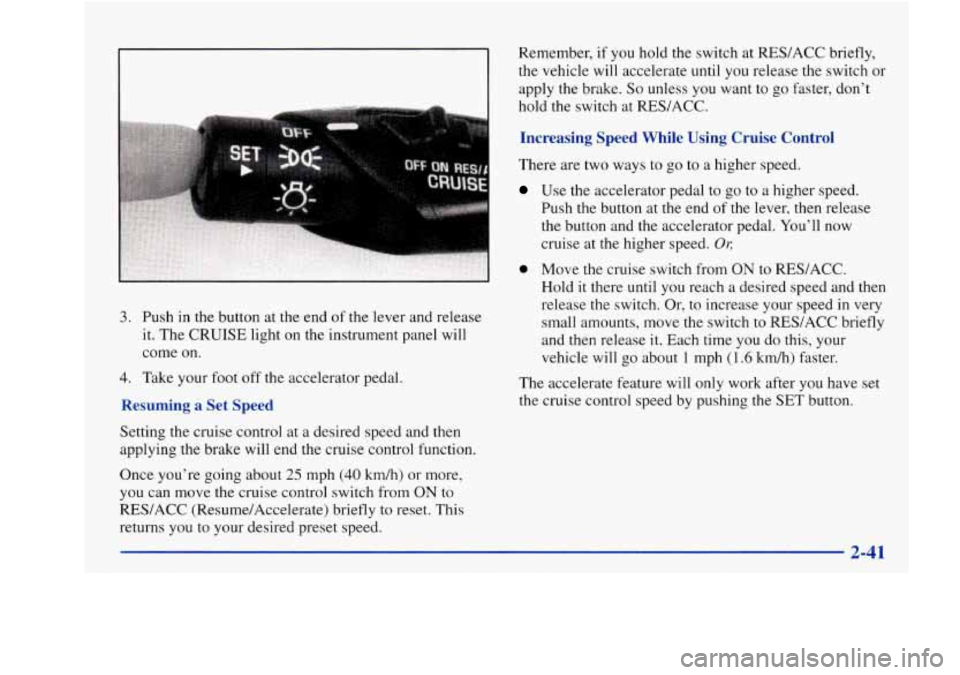
.... .. . .. . ..
3. Push in the button at the end of the lever and release
it.
The CRUISE light on the instrument panel will
come on.
4. Take your foot off the accelerator pedal.
Resuming a Set Speed
Setting the cruise control at a desired speed and then
applying the brake will end the cruise control function.
Once you’re going about
25 mph (40 km/h) or more,
you can move the cruise control switch from
ON to
RES/ACC (Resume/Accelerate) briefly to reset. This
returns you to your desired preset speed. Remember,
if you hold the switch at RES/ACC briefly,
the vehicle will accelerate until you release the switch or
apply the brake.
So unless you want to go faster, don’t
hold the switch at RES/ACC.
Increasing Speed While Using Cruise Control
There are two ways to go to a higher speed.
Use the accelerator pedal to go to a higher speed.
Push the button at the end of the lever, then release
the button and the accelerator pedal. You’ll now
cruise at the higher speed.
01;
0 Move the cruise switch from ON to RES/ACC.
Hold
it there until you reach a desired speed and then
release the switch. Or, to increase your speed in very
small amounts, move the switch to RES/ACC briefly
and then release it. Each time you do this, your
vehicle will
go about 1 mph (1.6 km/h) faster.
The accelerate feature will only work after you have set
the cruise control speed by pushing the SET button.
Page 129 of 380

Speedometer Odometer and Trip Odometer
Your speedometer lets you see your speed in both miles
per hour (mph) and kilometers per hour
(M).
Your odometer shows how far your vehicle has been
driven in either miles (used in the United States) or
kilometers (used in Canada).
Your trip odometer tells you how
far you have driven
since you last reset it. Press the trip button located next
to the trip odometer below the fuel gage.
Your vehicle has a tamper resistant odometer.
If you see
silver lines between the numbers, you’ll know someone
has probably tampered with it and the numbers may not
be true.
You may wonder what happens
if your vehicle needs a
new odometer installed. If the new one can be set to the
mileage total of the old odometer, then it must be. But
if
it can’t, then it’s set at zero and a label must be put on
the driver’s door to show the old mileage reading when
the new odometer was installed.
2-63
Page 134 of 380
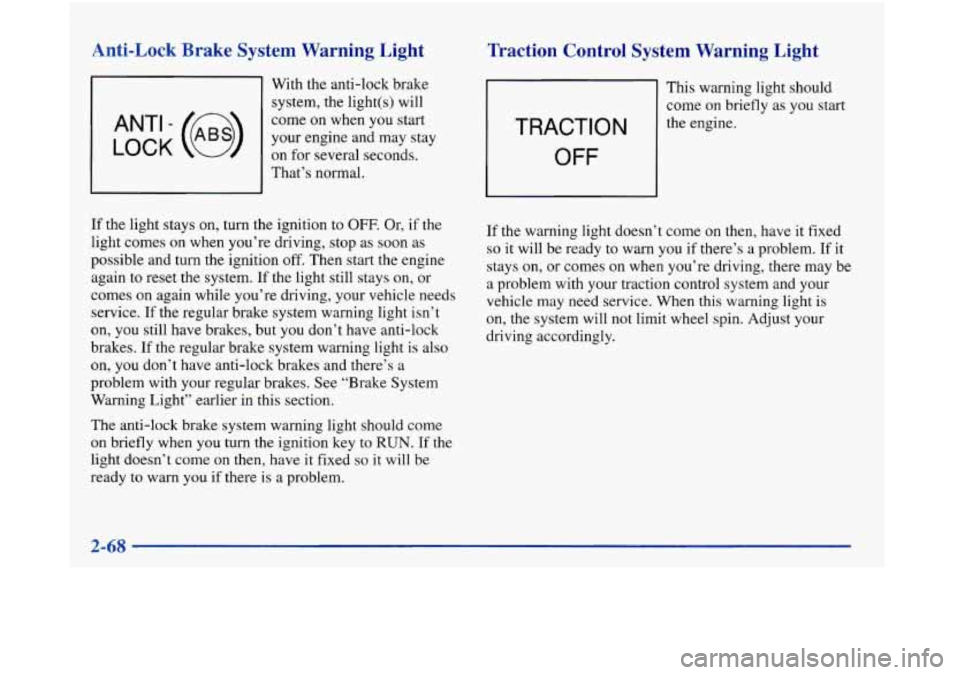
Anti-Lock Brake System Warning Light
With the anti-lock brake
system, the light(s) will
come on when you start
on for several seconds.
LOCK ANT’ - (@)
your engine and may stay
I I That’s normal.
Traction Control System Warning Light
TRACTION
OFF
This warning light should
come on briefly as you start
the engine.
If the light stays on, turn the ignition to
OFF. Or, if the
light comes on when you’re driving, stop as soon as
possible and turn the ignition off. Then start the engine
again to reset the system. If the light still stays on, or
comes on again while you’re driving, your vehicle needs
service.
If the regular brake system warning light isn’t
on, you still have brakes, but you don’t have anti-lock
brakes. If the regular brake system warning light is also
on, you don’t have anti-lock brakes and there’s a
problem with your regular brakes. See “Brake System
Warning Light” earlier in this section.
The anti-lock brake system warning light should come
on briefly when you turn the ignition key to
RUN. If the
light doesn’t come on then, have
it fixed so it will be
ready to warn you if there
is a problem. If
the warning light doesn’t corne on then, have it fixed
so it
will be ready to warn you if there’s a problem. If it
stays
on, or comes on when you’re driving, there may be
a problem with your traction control system and your
vehicle may need service. When this warning light
is
on, the system will not limit wheel spin. Adjust your
driving accordingly.
2-68
Page 142 of 380
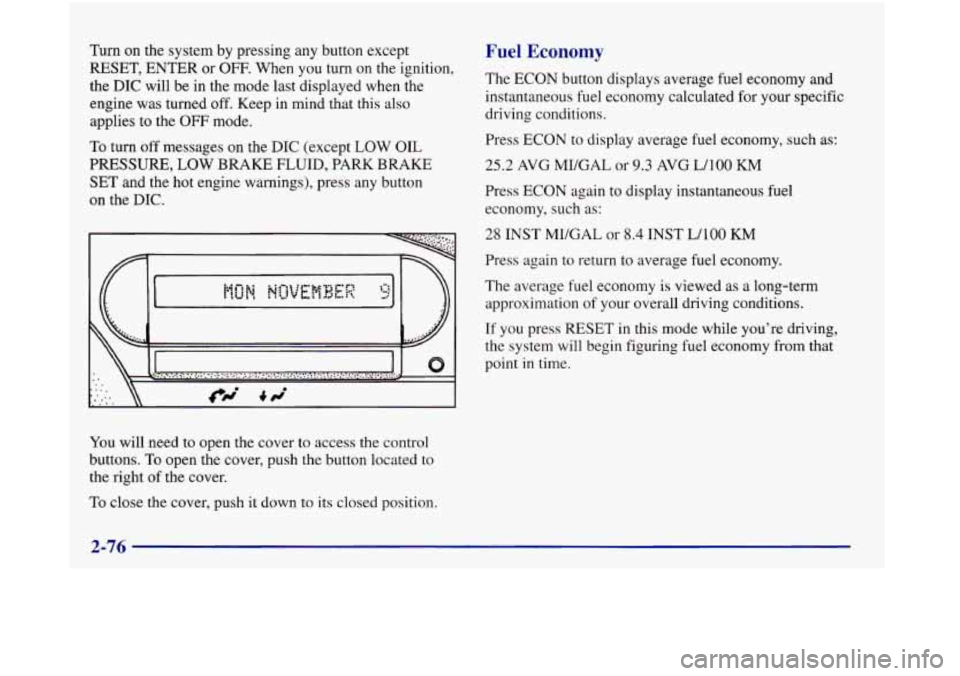
Turn on the system by pressing any button except
RESET, ENTER or OFF. When you turn on the ignition,
the
DIC will be in the mode last displayed when the
engine was turned off. Keep in mind that this also
applies to the
OFF mode.
To turn off messages on the DIC (except LOW OIL
PRESSURE, LOW BRAKE FLUID, PARK BRAKE
SET and the hot engine warnings), press any button
on the DIC.
\ II
You will need to open the cover to access the control
buttons.
To open the cover, push the button located to
the right
of the cover.
To close the cover, push it down to its closed position.
Fuel Economy
The ECON button displays average fuel economy and
instantaneous fuel economy calculated for your specific
driving conditions.
Press ECON to display average fuel economy, such as:
25.2 AVG MI/GAL or 9.3 AVG WlOO KM
Press ECON again to display instantaneous fuel
economy, such as:
28 INST MUGAL or 8.4 INST WlOO KM
Press again to return to average fuel economy.
The average fuel economy is viewed as a long-term
approximation
of your overall driving conditions.
If you press RESET in this mode while you’re driving,
the system will begin figuring fuel economy from that
point
in time.
Page 143 of 380
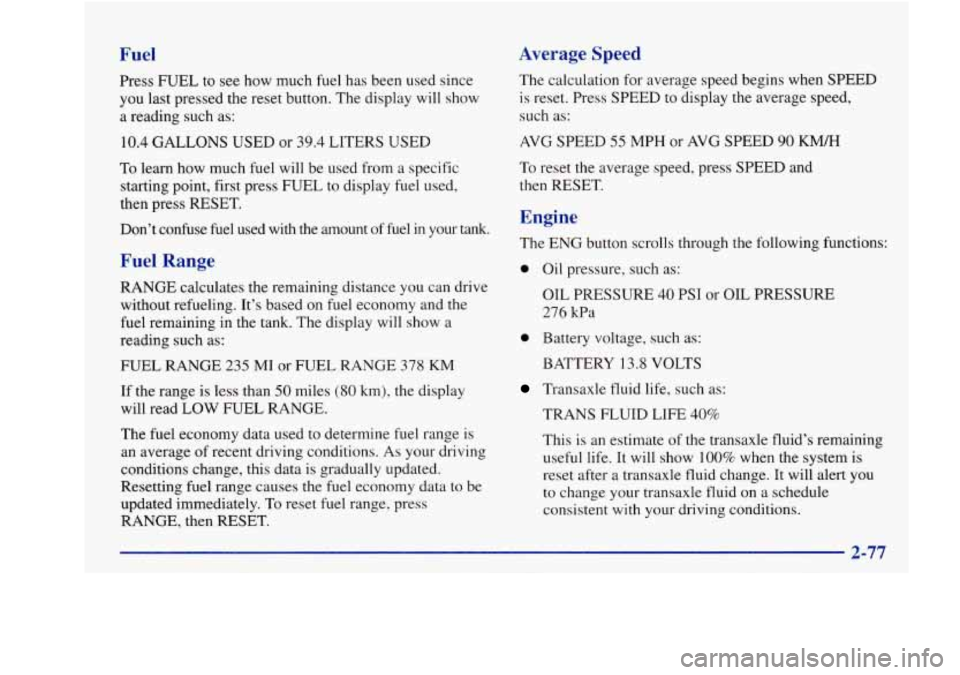
Fuel
Press FUEL to see how much fuel has been used since
you last pressed the reset button. The display will show
a reading such as:
10.4 GALLONS USED or 39.4 LITERS USED
To learn how much fuel will be used from a specific
starting point, first press FUEL to display fuel used,
then press RESET.
Don’t confuse fuel used with
the amount of fuel in your tank.
Fuel Range
RANGE calculates the remaining distance you can drive
without refueling. It’s based on fuel economy and the
fuel remaining in the tank. The display will show a
reading such as:
FUEL RANGE
235 MI or FUEL RANGE 378 KM
If the range is less than 50 miles (80 km), the display
will read LOW FUEL RANGE.
The fuel economy data used to determine fuel range is
an average of recent driving conditions.
As your driving
conditions change, this data is gradually updated.
Resetting fuel range causes the fuel economy data to be
updated immediately. To reset fuel range, press
RANGE, then RESET.
Average Speed
The calculation for average speed begins when SPEED
is reset. Press SPEED to display the average speed,
such as:
AVG SPEED 55 MPH or AVG SPEED 90 KM/H
To reset the average speed, press SPEED and
then RESET.
Engine
The ENG button scrolls through the following functions:
0 Oil pressure, such as:
OIL PRESSURE
40 PSI or OIL PRESSURE
276 Wa
0 Battery voltage, such as:
BATTERY
13.8 VOLTS
Transaxle fluid life, such as:
TRANS FLUID
LIFE 40%
This is an estimate of the transaxle fluid’s remaining
useful life. It will show 100% when the system is
reset after a transaxle fluid change. It
will alert you
to change your transaxle fluid on a schedule
consistent with your driving conditions.
Page 144 of 380
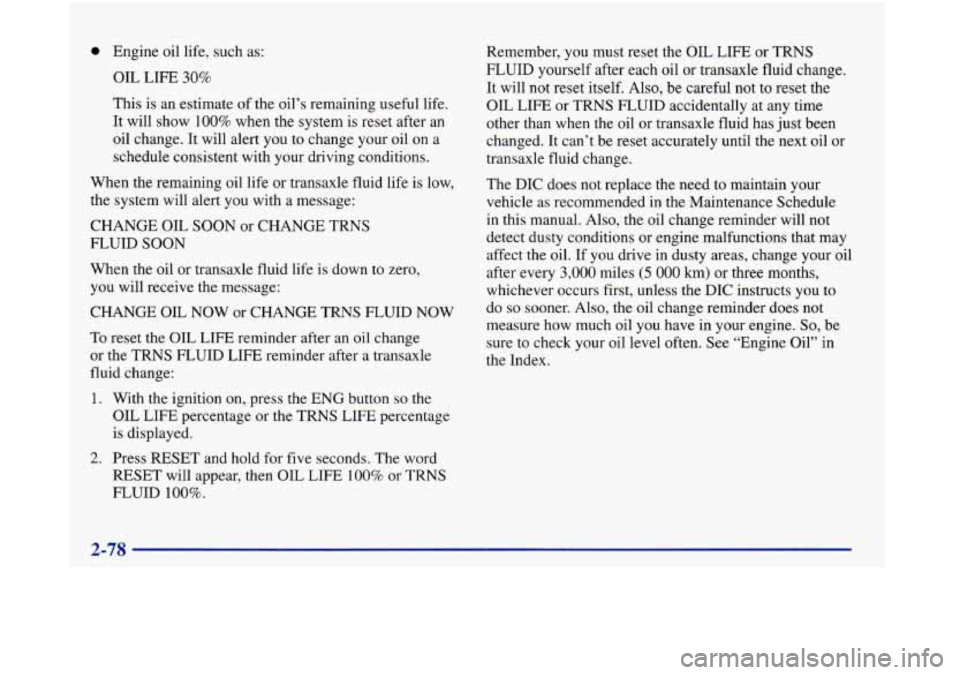
0 Engine oil life, such as:
OIL LIFE 30%
This is an estimate of the oil’s remaining useful life.
It will show
100% when the system is reset after an
oil change.
It will alert you to change your oil on a
schedule consistent with your driving conditions.
When the remaining oil life or transaxle fluid life is low,
the system will alert you with a message:
CHANGE
OIL SOON or CHANGE TRNS
FLUID SOON
When the oil or transaxle fluid life is down to zero,
you will receive the message:
CHANGE OIL NOW or CHANGE TRNS FLUID NOW
To reset the OIL LIFE reminder after an oil change
or the TRNS FLUID LIFE reminder after a transaxle
fluid change:
1. With the ignition on, press the ENG button so the
OIL LIFE percentage or the TRNS LIFE percentage
is displayed.
2. Press RESET and hold for five seconds. The word
RESET will appear, then OIL LIFE
100% or TRNS
FLUID 100%.
Remember, you must reset the OIL LIFE or TRNS
FLUID yourself after each oil or transaxle fluid change.
It will not reset itself. Also, be careful not to reset the
OIL LIFE
or TRNS FLUID accidentally at any time
other than when the oil or transaxle fluid has just been
changed. It can’t be reset accurately until the next oil or
transaxle fluid change.
The DIC does not replace the need to maintain your
vehicle as recommended in the Maintenance Schedule
in this manual. Also, the oil change reminder will not
detect dusty conditions or engine malfunctions that may
affect the oil. If you drive in dusty areas, change your oil
after every
3,000 miles (5 000 km) or three months,
whichever occurs first, unless the DIC instructs you to
do
so sooner. Also, the oil change reminder does not
measure how much oil you have in your engine.
So, be
sure to check your oil level often. See “Engine Oil” in
the Index.
2-78
Page 145 of 380
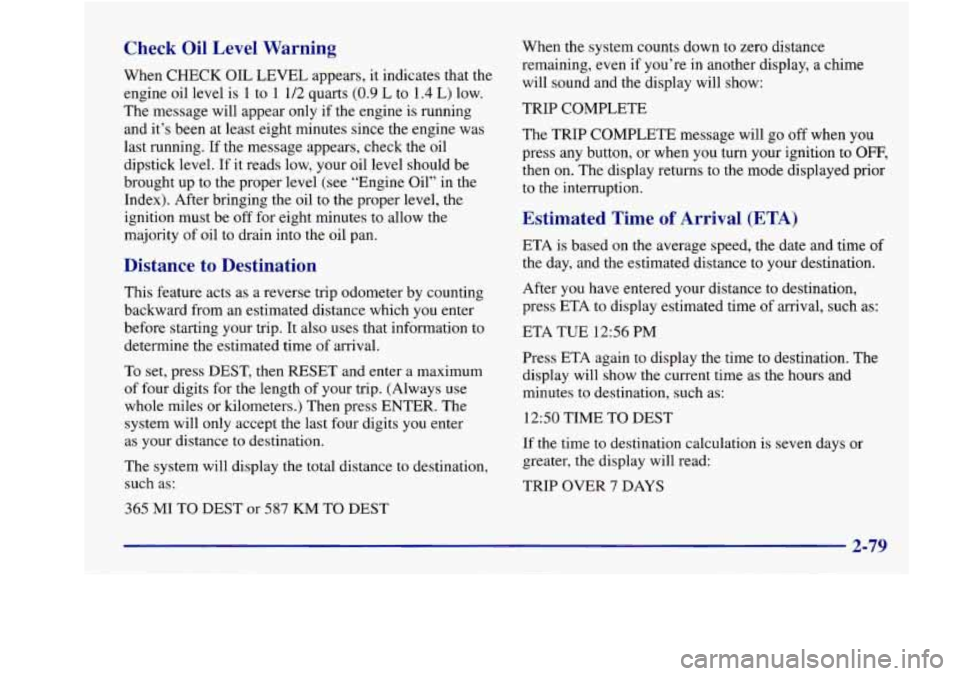
Check Oil Level Warning
When CHECK OIL LEVEL appears, it indicates that the
engine oil level is 1 to
1 1/2 quarts (0.9 L to 1.4 L) low.
The message will appear only if the engine is running
and it’s been at least eight minutes since the engine was
last running. If the message appears, check the oil
dipstick level. If it reads low, your oil level should be
brought up to the proper level (see “Engine Oil” in the Index). After bringing the oil to the proper level, the
ignition must be off for eight minutes to allow the
majority
of oil to drain into the oil pan.
Distance to Destination
This feature acts as a reverse trip odometer by counting
backward from an estimated distance which you enter
before starting your trip.
It also uses that information to
determine the estimated time of arrival.
To set, press DEST, then
RESET and enter a maximum
of four digits for the length
of your trip. (Always use
whole miles or kilometers.) Then press ENTER. The
system will only accept the last four digits you enter
as your distance to destination.
The system will display the total distance to destination,
such as:
365 MI TO DEST or 587 KM TO DEST When
the system counts down
to zero distance
remaining, even
if you’re in another display, a chime
will sound and the display will show:
TRIP COMPLETE
The TRIP COMPLETE message will go off when you
press any button, or when you turn your ignition to
OFF,
then on. The display returns to the mode displayed prior
to the interruption.
Estimated Time of Arrival (ETA)
ETA is based on the average speed, the date and time of
the day, and the estimated distance to your destination.
After you have entered your distance to destination,
press ETA to display estimated time
of arrival, such as:
ETA TUE
12% PM
Press ETA again to display the time to destination. The
display will show the current time
as the hours and
minutes to destination, such as:
1250 TIME
TO DEST
If the time to destination calculation is seven days or
greater, the display will read:
TRIP OVER
7 DAYS